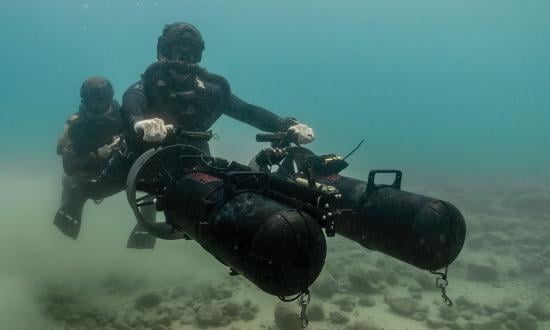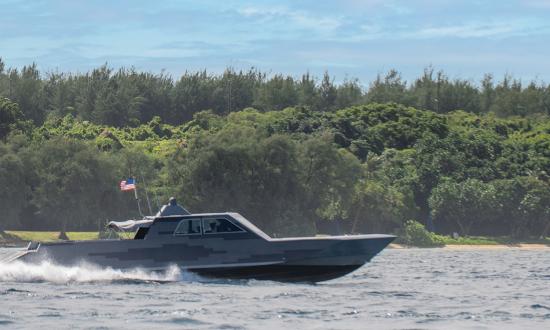In a potential strategic conflict, the U.S. joint force must be prepared to counter adversary special operations forces (SOF) threatening U.S. national interests at home and abroad. The severity of these threats and the differences between conventional and special operations forces call for a joint strategy that better integrates U.S. Special Operations Command expertise with conventional force capabilities.
SOF Characteristics
Several characteristics emphasize the challenges—and opportunities—adversary SOF present for the joint force:
Speed and strategic effects. Special operations usually are rapid clandestine or covert actions aimed at causing decisive strategic effects. They typically are conducted in sensitive areas under demanding time constraints and high operational risk. In addition, SOF operate deep behind enemy lines against critical targets.1
Adversary SOF likely would be employed for surgical attacks to prepare the battlespace for a larger conventional force.2 They would precede or act as forcible entry forces to identify, clarify, establish, or modify conditions necessary for a lodgment and eventual force breakout. Specifically, adversary SOF likely would seize small, initial lodgments at targets necessary for follow-on conventional force movement and maneuver, such as airfields, seaports, and rail centers. They also may provide or assist with fire support and reconnaissance that conventional forces are incapable of or not structured to execute.3
Signature management. SOF manage their signatures to obfuscate mission profiles and complicate countertargeting efforts. Like other modern military components, they are highly dependent on the electromagnetic spectrum, including for communications and intelligence; however, their requirements are lower than those of conventional forces, which allows them to operate relatively independent of burdensome communication structures.4 In addition, SOF prioritize sophisticated communication systems incorporating satellite relays or encryption to protect against detection.5
Specialized platforms. SOF often require specialized vehicles for infiltration, operation, and exfiltration. Examples include modified helicopters and four-wheeled vehicles designed for austere environments. Maritime SOF also have unique equipment, such as diver propulsion vehicles and undersea personnel delivery systems that launch from host vessels.6
These three aspects of SOF are directly relevant when establishing a counter-SOF strategy. Identifying own force vulnerabilities, especially those with operational and strategic ramifications across theaters, can provide insight into likely targets of adversary SOF. Specialized intelligence processes can undermine their signature management efforts and identify the distinct signatures of their specialized platforms, as well as their unique supply chains, making countertargeting efforts more successful.
Expertise and Intel
Integrating Special Operations Command’s expertise—especially its understanding of special operations tactics, techniques, and procedures—in the conventional force offers a way to develop a counter-SOF strategy. This expertise would be most effective if fully integrated into joint force operational planning and mission execution, which could include Special Operations Command liaising directly with the theater component commands to integrate, coordinate, and deconflict operations and ensure SOF support is oriented around counter-SOF efforts. The likely source for SOF liaison officers would be the theater special operations commands (TSOCs), which are uniquely suited to provide broad and continuous mission support for their respective geographic combatant commands (GCCs).7
With responsibility for manning, training, and equipping the friendly SOF community, including developing strategies and doctrines relevant to the geographic combatant commands, Special Operations Command could lead the development of a counter-SOF strategy for the joint force, with input from the conventional force of each GCC. This strategy could be disseminated through the TSOCs and operationalized by GCC conventional forces.
Specialized intelligence would be a critical element in implementing a counter-SOF strategy and the integration of friendly SOF and conventional forces. Given the speed of SOF operations, intelligence must be prompt and tailored to the needs of operational commanders countering adversary SOF—for example, to support dynamic targeting, such as close air support, for kinetic and non-kinetic fires by the conventional force.8 The specialized intelligence to support a counter-SOF strategy would require more efficient intelligence processes and authoritative direction of the intelligence community to meet the demands of conventional force operational commanders.
A Necessary Component
Some may argue that SOF are not relevant or critical in a strategic conflict. They and their high-value skills would be too susceptible to loss during such a conflict. The use of devastating force by conventional forces would negate any benefit from including SOF in operational fires. And, finally, joint warfighting concepts see conventional forces as the central component of strategic conflict, with minimal consideration for the employment of SOF.
However, the consequences of failing to have a counter-SOF strategy and the lack of time for adopting one once conflict erupts speak to the need to have a joint strategy in place early. As in all military operations, the adversary will seek to attack friendly centers of gravity. To prepare, the joint force should determine its critical vulnerabilities, which are likely to be targets for adversary SOF. Adversary SOF are particularly threatening to the joint security areas that support the theater-wide sustainment operations critical for continued conventional force actions.9 Unchecked, adversary SOF could strike air and sea points of departure, troop locations, and lines of communication to inflict strategic, decisive, and lasting effects.10 Given the devastating ramifications of adversary SOF, developing a counter-SOF strategy after such strikes will be too late.
SOF will likely be a central component of an adversary’s strategy in a high-end conflict. They are force multipliers, an asymmetric counter to a technological overmatch. In addition, adversary SOF, especially maritime SOF, threaten rear areas that would be critical for U.S. sustainment and force projection in a strategic conflict. Adversaries likely will recognize the immense benefits of special operations and the impact they could have on the joint force’s ability to conduct and sustain military operations.11
A Joint Strategy Framework
The following nine principles should be considered when developing a counter-SOF strategy:
• Specialized intelligence processes are critical.
• Identifying own force vulnerabilities provides invaluable insight.
• Anticipating friendly force and line penetration is important.
• Adaptability of friendly forces to contend with force infiltration is imperative.
• Rapid countering actions may prove decisive.
• Targeting specialized platforms is worth the effort.
• SOF-on-SOF engagements should be avoided at all cost.
• Massed conventional forces are a credible deterrent.
• Overwhelming firepower should be part of the plan to isolate and defeat SOF.
These principles are not all-inclusive, but they contribute to an overall framework for a counter-SOF strategy.
Strategic conflict will include the threat of adversary SOF, which demands forethought—i.e., developing a joint strategy for countering adversary SOF efforts with conventional forces. Integrating joint force capabilities and Special Operations Command expertise to build such a strategy is possible and should be prioritized, to provide operational commanders guidance before conflict erupts.
1. See Joint Chiefs of Staff, Joint Publication 3-05, Special Operations (Washington, DC: Department of Defense, 16 July 2014), I-1; and William Rosenau, Special Operations Forces and Elusive Enemy Ground Targets: Lessons from Vietnam and the Persian Gulf War (Santa Monica, CA: Project Air Force/Rand, 2001), 36.
2. John B. Alexander, The Changing Nature of Warfare, the Factors Mediating Future Conflict, and Implications for Special Operations Forces (Hurlburt Field, FL: JSOU Press, 2006), 37.
3. Joint Chiefs of Staff, Joint Publication 3-0, Joint Campaigns and Operations (Washington, DC: Department of Defense, 18 June 2022), vii–22.
4. Alexander, The Changing Nature of Warfare, 39.
5. Joint Publication 3-05, Special Operations, I-1.
6. Rosenau, Special Operations Forces, 35; and John Chen and Joel Wuthnow, China Maritime Report No. 18: Chinese Special Operations in a Large-Scale Island Landing (Newport, RI: Naval War College China Maritime Studies Institute, 2022), 9
7. Joint Publication 3-05, Special Operations, I-3.
8. Joint Chiefs of Staff, Joint Publication 3-09, Joint Fire Support (Washington, DC: Department of Defense, 10 April 2019), iv–13, 14.
9. Joint Chiefs of Staff, Joint Publication 3-10, Joint Security Operations in Theater (Washington, DC: Department of Defense, 25 July 2019), iv–13.
10. Joseph F. Whelan, Countering Enemy Special Purpose Forces: An Evolving Mission for United States Special Operations Forces? (Fort Leavenworth, KS: U.S. Army Command and General Staff College, School of Advanced Military Studies, 2001), 17.
11. Yair Ansbacher and Ron Schleifer, “How Special Operations Forces Can Contribute Strategically to Modern Wars: An Israel-US Case Study Comparison,” The RUSI Journal 166, no. 4 (August 2021): 39.







